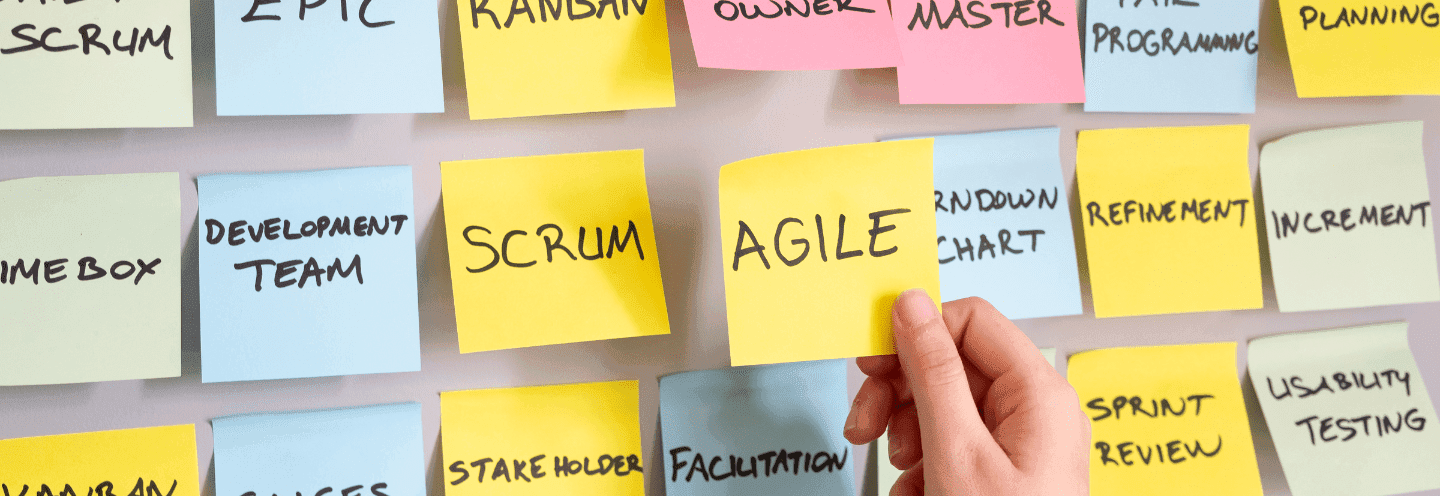Is your business stuck in slow motion? The market is on fast forward, but your development process is stuck in rewind. Ditch the old methods and use an approach that’s efficient, adaptable, and keeps you moving at the speed of innovation.
That’s where agile methodologies come in. Agile development methodologies have revolutionized the software development industry, enabling teams to deliver high-quality products faster and more effectively than ever before. In this article, we’ll explore agile development methodologies in mobile app development, including their types, benefits, and which methodologies to implement for your project.
What are Agile Development Methodologies?
Agile methodologies are a set of principles and practices that ditch the rigid, waterfall approach for a flexible system built on three pillars: continuous value delivery, rapid adaptation, and strong collaboration.
Teams work iteratively, delivering features frequently and incorporating feedback for constant improvement. This adaptability allows them to respond quickly to changing needs and markets, while the cross-functional collaboration ensures everyone works together to achieve a high-quality final product.
Agile Development Methodologies vs. Traditional Development Methods
To fully understand the power of agile development methodologies, it is important to compare them with traditional development methods.
Sequential Approach of Traditional Development
Traditional development methods, such as the waterfall model, follow a sequential approach where each phase of the project is completed before moving on to the next. This linear approach can be inflexible, making it difficult to accommodate changes and respond to evolving requirements.
Adaptive and Iterative Nature of Agile Methodologies
In contrast, agile methodologies are adaptive and iterative, allowing for incremental delivery of value. Agile teams work in short iterations, delivering working software at the end of each iteration. This enables teams to gather feedback early and often, ensuring that the final product meets customer expectations.
Customer Involvement and Feedback
Another key difference between agile and traditional development methods is the level of customer involvement. Traditional methods often involve limited customer interaction, with requirements being defined upfront and little opportunity for feedback until the final product is delivered. Agile methodologies prioritize customer collaboration and feedback throughout the development process. By involving customers early and often, agile teams can ensure that the final product meets their needs and expectations. This customer-centric approach reduces the risk of building a product that does not resonate with the target audience and increases overall customer satisfaction.
Self-Organizing and Cross-Functional Teams
Agile methodologies promote self-organizing and cross-functional teams. Unlike traditional methods, where roles and responsibilities are often predefined, agile teams are empowered to make decisions collectively, promoting a sense of ownership and accountability. By breaking down silos and encouraging cross-functional collaboration, agile methodologies enable teams to leverage the diverse skills and expertise of their members, leading to better outcomes and higher-quality products.
Now that we’ve thrown out the dusty rulebook of traditional development and harnessed the agility revolution! Let’s further explore some of the most valuable benefits of agile methodologies, like how Agile keeps projects on track, boosts customer satisfaction, and empowers teams to continuously improve.

Benefits of Agile Development Methodologies
Agile development methodologies offer a wide range of benefits for software development teams and businesses alike. By incorporating an agile approach, teams can improve productivity, increase customer satisfaction, and reduce project risks.
Ability to adapt to change
In traditional development methods, requirements are often defined upfront and locked in for the duration of the project. This approach can lead to delays when changes inevitably arise. Agile methodologies, on the other hand, encourage change and allow for flexibility in requirements. This enables teams to respond quickly to new information and deliver a product that better meets customer needs.
Boost collaboration & communication
Agile teams work closely together, breaking down silos and cultivating cross-functional collaboration. This leads to better communication, increased transparency, and improved decision-making. By involving stakeholders throughout the development process, it ensures that everyone is aligned and working towards a common goal. This not only improves the quality of the final product but also increases customer satisfaction and reduces the risk of miscommunication.
Promote a culture of continuous improvement
Through regular reviews, teams reflect on their processes and identify areas for improvement. This continuous feedback loop allows teams to learn from their mistakes, make necessary adjustments, and continuously enhance their development practices. By embracing a culture of continuous improvement, teams can deliver higher-quality products and increase their overall efficiency.
Types of Agile Development Methodologies
With the agility mindset firmly in place, let’s get into the specifics and discuss some of the most popular types of agile methodologies that empower teams to harness this flexibility and deliver exceptional results.
Scrum
Scrum is one of the most widely used agile methodologies. It is a framework that emphasizes collaboration, iterative development, and self-organization. Scrum teams work in short sprints, typically lasting two to four weeks, and deliver a potentially shippable product increment at the end of each sprint. The Scrum framework consists of various roles, including the Scrum Master, Product Owner, and Development Team. It also incorporates ceremonies such as daily stand-ups, sprint planning, sprint reviews, and retrospectives.
Kanban
Kanban is a visual framework that focuses on flow and continuous improvement. Kanban boards are used to visualize work items and their progress, providing a clear overview of the team’s workflow. Kanban teams aim to limit work in progress (WIP) and optimize the flow of work through the system. By visualizing the workflow and limiting WIP, Kanban teams can identify bottlenecks, eliminate waste, and continuously improve their processes. Kanban is known for its flexibility and adaptability, making it suitable for a wide range of projects and teams.
Lean Development
Lean development, also known as Lean Agile, is an approach that combines agile principles with lean thinking. It aims to maximize customer value while minimizing waste and inefficiency. Lean development focuses on delivering value quickly, eliminating non-value-added activities, and continuously improving processes. It emphasizes the importance of customer collaboration, just-in-time delivery, and continuous learning. Lean development draws inspiration from various sources, including lean manufacturing, the Toyota Production System, and agile methodologies.
Crystal
Crystal is a family of agile methodologies that prioritize people and interactions over processes and tools. Crystal methodologies recognize that every project is unique and adapt accordingly. They vary in size, complexity, and team structure, with different Crystal methodologies suited for different types of projects. Crystal methodologies focus on clear communication, frequent delivery, and team collaboration. They emphasize the importance of keeping the team small and cohesive, enabling effective communication and decision-making.
Extreme Programming (XP)
Extreme Programming, or XP, is an agile methodology that emphasizes close collaboration between developers and customers. XP is known for its focus on software quality and technical excellence. It incorporates practices such as test-driven development (TDD), pair programming, continuous integration, and frequent refactoring. XP teams work in short iterations, delivering working software at the end of each iteration. The emphasis on customer collaboration and high-quality code makes XP particularly suitable for projects with rapidly changing requirements and a strong focus on software craftsmanship.

Choosing the Right Agile Development Methodology for Your Project
With the various types of agile development methodologies available, choosing the right one for your project can be a daunting task. The decision should be based on factors such as project size, complexity, team structure, and customer needs.
Each methodology has its strengths and weaknesses, and what works for one project may not work for another.
When selecting an agile methodology, it is essential to consider the following:
Project Size and Complexity: For larger and more complex projects, methodologies like Scrum or Lean Development may be more suitable. These methodologies provide a structured framework and allow for effective management of complex projects.
Team Structure and Expertise: The composition and expertise of your team can also influence the choice of methodology. If you have a small, cross-functional team with expertise in a specific area, Crystal methodologies may be a good fit. On the other hand, if you have a team that values technical excellence and collaboration, Extreme Programming might be the right choice.
Customer Collaboration and Feedback: If customer collaboration and frequent feedback are critical to your project’s success, methodologies like Scrum or Extreme Programming may be the most appropriate. These methodologies prioritize customer involvement and provide mechanisms for regular feedback and validation.
Flexibility and Adaptability: If your project requires a high degree of flexibility and adaptability, Kanban or Lean Development may be the best options. These methodologies allow for continuous reprioritization and adaptation to changing requirements.
Ultimately, the choice of agile development methodology should align with your project’s specific requirements, team dynamics, and customer needs. It is important to evaluate the strengths and weaknesses of each methodology and select the one that best fits your project’s unique circumstances.
Agile Development Methodology Success Stories
We’ve unpacked the power of agile methodologies and explored the diverse options available. Let’s now draw inspiration from real-world examples of industry leaders leveraging agile to achieve remarkable results. Agile development methodologies have seen widespread adoption across various industries, leading to remarkable success stories.
Spotify: Spotify, the popular music streaming platform, attributes its success to agile development methodologies. The company used the “Spotify Model,” a unique agile framework that focuses on autonomy, alignment, and adaptability. By organizing teams into autonomous squads, tribes, chapters, and guilds, Spotify created a scalable and agile organization that can adapt to changing market dynamics and deliver innovative products.
Amazon: Amazon, the e-commerce giant, is known for its relentless focus on customer needs and continuous innovation. Agile development methodologies are at the core of Amazon’s success, enabling the company to deliver new features and updates to its platform at a rapid pace. By prioritizing customer collaboration, frequent iterations, and continuous improvement, Amazon stays ahead of its competitors and consistently delivers a superior customer experience.
Netflix: Netflix, the leading streaming service, relies on agile development methodologies to stay agile in a highly competitive market. The company uses a unique agile framework called “Netflix Culture,” which emphasizes freedom and responsibility. Netflix empowers its employees to make decisions and take ownership of their projects, fostering a culture of innovation and continuous learning.
These success stories demonstrate the power of agile development methodologies in driving innovation, delivering value, and staying ahead of the competition.

The ability to adapt quickly, deliver value incrementally, and collaborate effectively are essential for success in the software development industry. Agile methodologies offer a flexible and iterative approach that enables teams to respond to changing requirements, deliver high-quality products, and exceed customer expectations.
These diverse methodologies empower teams to work together towards a common goal, leverage their collective skills and expertise, and deliver outstanding results.
So, if you’re looking to achieve unrivaled success in your software development projects, it’s time to embrace agile development methodologies. Whether you choose Scrum, Kanban, Lean Development, Crystal, or Extreme Programming, the key is to adapt the methodology to your project’s unique requirements and context. By doing so, you will unleash the power of agile development methodologies and pave the way for a future of unparalleled success.


